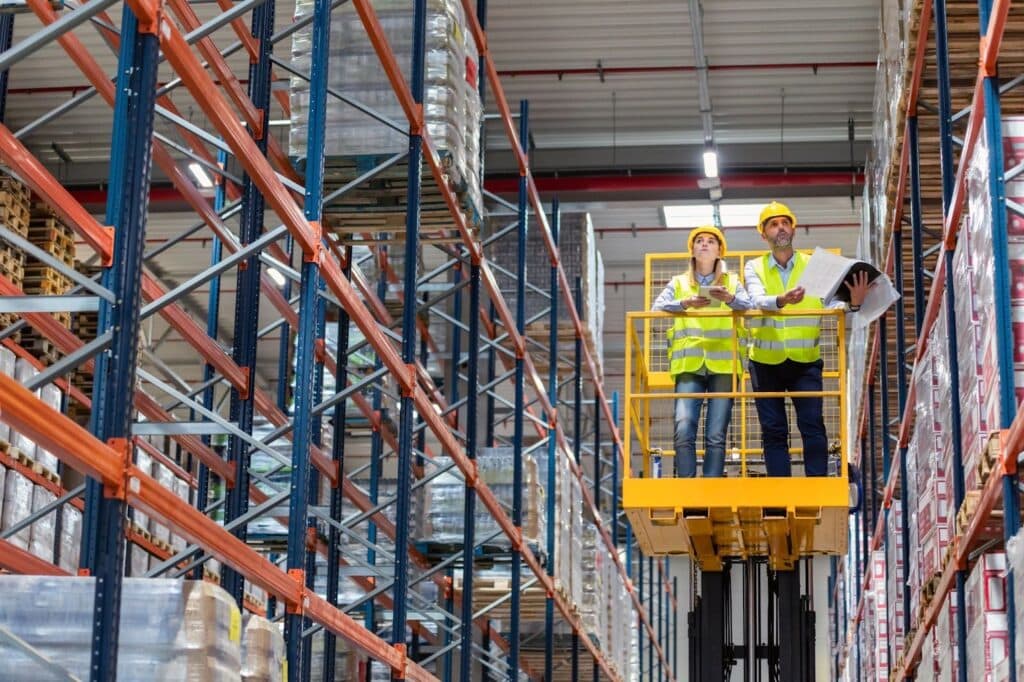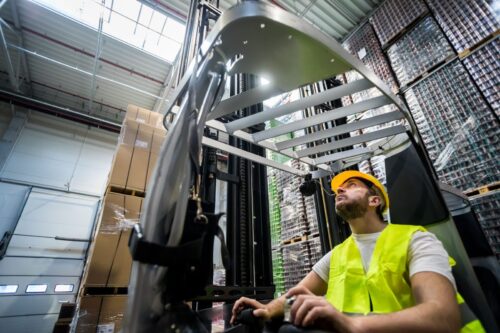Vertical Warehousing: What It Is, Analyzing, and Benefits

Logistics operations face increasing demands for smarter and space-saving storage strategies due to rapid growth in e-commerce and shifting consumer expectations. Businesses with limited floor space often struggle to scale efficiently without expanding their facility’s footprint.
Adopting vertical warehousing helps companies build upward rather than outward, maximizing storage capacity and enhancing operational flow. This innovative solution improves inventory management while helping to save floor space and reducing labor costs associated with horizontal layouts.
In this blog, you’ll learn how vertical warehousing transforms warehouse space by boosting efficiency and improving space utilization. It’s designed for logistics professionals seeking cutting-edge vertical storage solutions to stay competitive in the evolving supply chain landscape.
What Is Vertical Warehousing?
Vertical warehousing refers to a storage approach that uses vertical space to maximize storage capacity within a warehouse. Instead of expanding horizontally, businesses improve efficiency by building upward and utilizing available vertical space.
This construction strategy enhances space utilization and reduces the need for additional floor space while supporting better resource allocation. By integrating automated systems such as vertical lift systems and retrieval systems, facilities ensure smooth workflows and more accurate inventory management.
Efficient layouts also improve operator performance and streamline operations within a single facility footprint. Other key features include:
- Vertical lift modules and vertical carousels improve inventory management by organizing stored items efficiently, allowing for faster and easier retrieval and reducing time spent on repetitive tasks for operators.
- Optimized pallet racks and flow racks maximize warehouse space by storing more inventory vertically, ensuring efficient retrieval systems, and supporting seamless workflows in a single facility.
- Integrated warehouse management systems track stored goods in real-time, improving location accuracy, minimizing picking errors, and enabling operators to handle higher inventory levels efficiently and accurately.
By leveraging available vertical space, businesses achieve higher productivity and streamlined warehouse operations.
The Evolution of Vertical Warehousing
In the past, warehouses relied on horizontal expansion to store goods and increase storage capacity. However, rising real estate costs and limited available floor space made this approach unsustainable.
Modern vertical warehouses emerged as an effective solution, driven by advancements in automated storage technologies, including vertical lift modules and smart retrieval systems. These innovations enable facilities to store goods more efficiently and optimize space utilization.
Inventory studies show that vertical systems improve inventory management efficiency compared to traditional layouts. By adopting vertical designs, distribution centers, and logistics hubs meet increasing supply chain demands without increasing their facility’s footprint.
Analyzing the Efficiency of Vertical Warehousing
Maximizing productivity while reducing costs is crucial for supply chain success. Here’s how vertical warehousing enhances efficiency at every level.
Let’s understand how vertical systems redefine space utilization by providing maximum storage density:
Valuable Floor Space Optimization
Using vertical storage solutions reduces the need for sprawling facilities by taking advantage of vertical warehouse space. Expanding upward enables warehouses to store higher inventory levels efficiently within the same square foot, improving overall space utilization and helping to save space, thus reducing the demand for additional floor space.
Vertical lift modules and pallet racks ensure optimal use of available vertical space, making room for essential workflows and storage-related operations. Advanced space management enhances high-density storage while minimizing picking errors.
By adopting this approach, facilities streamline inventory management and create more efficient workflows, ensuring seamless storage processes throughout the facility without requiring horizontal expansions.
Cost Reduction
Using vertical warehousing solutions reduces labor costs and minimizes expenses related to land purchases or construction of new buildings. Instead of adding additional square footage, companies optimize their facility’s footprint by building vertically, saving time and money.
Efficient vertical storage avoids unnecessary expansion expenses and reduces long-term operational costs. By incorporating automated retrieval systems, businesses improve overall productivity by decreasing manual work, limiting repetitive tasks, and boosting workflow accuracy.
These automation technologies significantly reduce operating expenses and support a highly cost-effective warehouse strategy, ensuring that operations remain profitable even as inventory demands and business growth increase.
Increased Accessibility
Vertical storage systems, such as conveyor systems and automated vertical lift modules, improve easy access to items and enhance overall productivity by organizing stored goods for quicker retrieval. These advanced systems reduce time spent on repetitive tasks by streamlining the picking process, allowing operators to work faster and more accurately.
Smart warehouse management systems ensure precise inventory levels and keep records updated in real time, making stored goods easier to locate.
Streamlined workflows enable operators to handle larger workloads and meet growing business demands without delays, ensuring maximum efficiency and a smoother operational flow throughout the facility.
Benefits of Vertical Warehousing
Maximizing storage space while improving operational flow is crucial for competitive businesses. Vertical layouts increase productivity without expanding a facility’s footprint.
Explore the key benefits of vertical warehousing for modern logistics operations:
Maximum Storage Density
By utilizing vertical storage, businesses increase high-density inventory storage without expanding warehouse space. Implementing a vertical lift module (VLM) as part of the storage solution can significantly enhance space utilization. The VLM’s innovative design with tray storage and an elevator system optimizes space utilization and retrieval processes, ensuring more organized storage and preventing unnecessary overcrowding within the facility.
Higher inventory levels stored in one location enable more streamlined inventory management, significantly minimizing picking errors and improving workflow accuracy. Enhanced layouts boost operator performance, supporting faster retrieval systems and overall system efficiency.
With improved space utilization, businesses achieve optimized warehouse operations, leading to greater productivity, reduced downtime, and a more efficient storage strategy.
Sustainability Advantages
Efficient use of vertical warehouse storage systems reduces energy consumption and resource waste by optimizing facility layouts and minimizing construction requirements. Businesses lower their environmental footprint by avoiding unnecessary land use and building expansions.
Implementing automated systems reduces repetitive tasks, which minimizes resource waste and enhances sustainability practices. These environmentally conscious solutions increase operational efficiency while maintaining safety standards for operators.
By adopting eco-friendly practices, businesses support long-term sustainability goals while improving overall supply chain performance. This approach strengthens corporate responsibility, reduces carbon emissions, and supports sustainable growth in the logistics and warehousing sectors.
Technological Integration
Smart systems seamlessly integrate vertical warehousing solutions with advanced warehouse management technologies. Automated storage and retrieval systems track stored goods in real time, improving workflow visibility and optimizing the picking process for greater productivity.
Modern tools handle maximum payload capacities efficiently, ensuring coordinated operations between multiple locations for faster workflows. Advanced automation solutions reduce delays, enhance accuracy, and boost operator performance across the facility.
By adopting integrated technologies, businesses achieve higher system reliability and meet evolving supply chain demands. This well-structured integration supports strategic goals, enhances operational efficiency, and ensures smooth business operations over the long term.
Implementing Vertical Storage Solutions
Effective implementation requires planning and the right solution for your specific facility. Careful evaluation of design and technology is essential for success.
Let’s understand how to overcome key challenges when adopting vertical warehousing:
Structural Considerations
Implementing vertical storage systems requires a sound architectural design to support load-bearing requirements. Facilities must account for high-density shelving and pallet racking while ensuring safety. Reinforced warehouse structures prevent collapse and improve resilience.
Focusing on space utilization and avoiding damage during installation ensures a smooth integration. Engineering assessments at the process begins phase help address any construction limitations and meet compliance standards.
Selecting the Right Vertical Lift Systems
Choosing technologies such as automated retrieval systems and conveyor systems improves storage and system efficiency. For the automotive industry, vertical storage solutions like tire carousels are essential for maximizing automotive floor space. This allows for more efficient placement of service and repair bays in auto dealerships. Depending on the business scale, manual systems may complement automation for versatile operations.
Selecting solutions that support large inventory loads and enable easy retrieval enhances overall management. Custom configurations allow facilities to adapt while maximizing advantages like increased productivity and reduced downtime.
Automated Vertical Storage Solutions
Automated vertical storage solutions are revolutionizing the way warehouses utilize space and manage inventory. By leveraging vertical space, these systems significantly reduce the need for expansive floor space, allowing businesses to store more inventory within a compact footprint. This not only increases storage capacity but also frees up valuable floor space for other critical operations.
One of the standout features of automated vertical storage solutions is their integration with advanced warehouse management software. This integration streamlines inventory tracking and retrieval, ensuring that items are always accounted for and easily accessible. Real-time inventory tracking reduces the risk of stockouts and overstocking, enhancing overall inventory management.
The benefits of automated vertical storage solutions are manifold:
- Increased Storage Capacity: These systems maximize storage density by utilizing vertical space, allowing businesses to store more inventory without expanding their warehouse footprint.
- Improved Inventory Tracking: Automated systems provide real-time updates on inventory levels and locations, reducing errors and improving accuracy.
- Enhanced Security: With secure access controls and precise inventory tracking, these solutions help prevent theft and loss.
- Increased Productivity: Automated retrieval systems speed up the picking process, reducing the time spent on manual tasks and boosting overall efficiency.
By adopting automated vertical storage solutions, businesses can optimize their warehouse space, improve operational efficiency, and enhance inventory management.
Best Practices for Implementing Vertical Warehousing
Implementing vertical warehousing requires a strategic approach to ensure optimal performance and efficiency. Here are some best practices to consider:
- Assess Your Inventory: Begin by analyzing your inventory characteristics, such as size, weight, and frequency of use. This assessment will help determine the most suitable vertical storage solution for your needs.
- Evaluate Your Warehouse Space: Take a comprehensive look at your available floor space and vertical space. Understanding the layout and dimensions of your warehouse will guide the design and implementation of your vertical storage system.
- Choose the Right Equipment: Select vertical storage equipment that aligns with your specific inventory and warehouse requirements. Consider factors such as load capacity, retrieval speed, and integration capabilities.
- Train Your Staff: Proper training is crucial for the successful operation and maintenance of vertical storage systems. Ensure that your staff is well-versed in using the equipment and understands the best practices for handling inventory.
- Monitor and Adjust: Continuously monitor the performance of your vertical storage system. Regular assessments and adjustments will help optimize efficiency and address any issues that arise.
By following these best practices, businesses can effectively implement vertical warehousing solutions, maximizing their available floor space and enhancing overall operational efficiency.
Industries That Can Benefit from Vertical Storage
Vertical storage solutions offer significant advantages across various industries, helping them optimize warehouse space and improve inventory management. Here are some industries that can greatly benefit from these innovative storage systems:
- Automotive: Automotive manufacturers and distributors can utilize vertical storage solutions to maximize their warehouse space and streamline inventory tracking. This is particularly beneficial for managing a wide range of parts and components efficiently.
- Aerospace: In the aerospace industry, vertical storage solutions provide secure and efficient storage for high-value parts and equipment. These systems enhance inventory visibility and ensure quick retrieval, supporting timely production and maintenance processes.
- Healthcare: Healthcare providers and distributors can benefit from vertical storage solutions by securely storing and tracking medical supplies and equipment. This ensures that critical items are readily available and reduces the risk of stockouts.
- Manufacturing: Manufacturers can optimize their warehouse space and improve inventory management with vertical storage solutions. These systems support high-density storage and efficient retrieval, enhancing overall productivity and operational flow.
By adopting vertical storage solutions, these industries can achieve better space utilization, improved inventory accuracy, and enhanced operational efficiency.
Overcoming the Challenges of Traditional Warehousing
Traditional warehousing methods often come with several challenges that can hinder efficiency and increase costs. Here’s how vertical storage solutions can address these issues:
- Limited Floor Space: Traditional warehousing requires extensive floor space, which can be both expensive and limited. Vertical storage solutions optimize floor space by utilizing vertical space, significantly increasing storage capacity without the need for horizontal expansion.
- Inefficient Inventory Tracking: Manual inventory tracking in traditional warehousing is time-consuming and prone to errors. Vertical storage solutions offer real-time inventory tracking, reducing the risk of stockouts and overstocking, and ensuring accurate inventory management.
- High Labor Costs: Traditional warehousing often relies on manual labor for inventory retrieval, which can be costly and inefficient. Vertical storage solutions automate the retrieval process, reducing labor costs and increasing productivity.
- Security Concerns: Traditional warehousing methods can be vulnerable to theft and loss. Vertical storage solutions provide secure access controls and precise inventory tracking, enhancing security and preventing unauthorized access.
By overcoming these challenges, vertical storage solutions offer a more efficient, cost-effective, and secure approach to warehouse management, ensuring businesses can meet growing demands and achieve long-term success.
Conclusion
Maximizing warehouse space through vertical warehousing improves storage capacity and enhances operational flow without expanding a facility’s footprint. Businesses gain significant advantages by using vertical warehouse storage systems that increase inventory efficiency and support manual systems or automation.
Adopting vertical storage enables better management of stored goods while reducing construction costs and avoiding damage. By choosing the right solution, companies enhance safety, productivity, and resource allocation.
Effective systems provide seamless, easy retrieval, helping operators meet demands in one location. Investing in vertical solutions strengthens business operations and provides long-term scalability, ensuring an efficient warehouse strategy for future growth.


